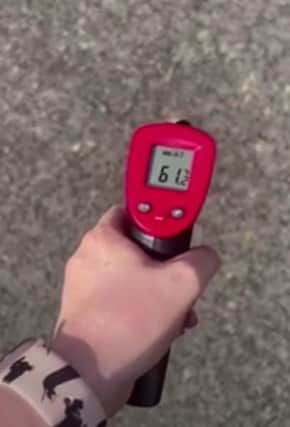RSPCA urges dog owners not to walk pets as video shows pavement reach shocking SIXTY DEGREES


The Met Office has issued a Red Extreme heat national severe weather warning for parts of central, northern, eastern and southeastern England, and the RSPCA’s dog welfare expert, Esme Wheeler, has urged pet owners to take urgent steps to keep their animals safe during the intense heat.
The charity has also released a video showing how quickly the temperature of pavements can rise.
Advertisement
Hide AdAdvertisement
Hide AdEsme said: “This weather is extreme and it’s a life or death situation for some people, let alone animals, who rely on us to help them survive the intense temperatures. We all have a duty to take every precaution possible.
“These few days of extreme hot weather need to be taken very seriously, that means staying inside or wherever it is coolest, skipping walking dogs and riding horses, and doing everything we can to provide shade and fresh water for wildlife. Our video shows just how hot the pavements alone can get - they become ‘paw-scorching’ and are a huge risk to animals."
Take these essential steps to help animals during the intense heat:
Provide several water bowls around the home for pets to drink often. Place containers of water outside for wild animals. Do not take your dog on a car journey unless absolutely necessary. Try to keep at least one room in the home as cool as possible by closing curtains or using a fan (out of reach) to encourage good airflow. Check pets and outdoor animals such as chickens and small furries every hour for signs of heatstroke, fly-strike or sunburn and keep water topped up. Do not take your dog out for a walk or exercise - it may be possible to take them for a gentle walk on the lead when the sun has gone down either early morning or late at night. Keep toilet breaks for dogs very brief and try to stick to shaded spots as much as you possibly can. If your dog, cat or small furry looks uncomfortable , try wrapping an ice pack or frozen water bottle in a tea towel and place it near them to lie next to, or use damp towels for your pet to lie on. Dogs die in hot cars. Call 999 in an emergency if you see a dog in a hot car.
Advertisement
Hide AdAdvertisement
Hide AdThe RSPCA has just launched its Cancel Out Cruelty summer appeal which highlights how - as the temperatures rise - so do calls to the charity’s cruelty hotline.
Esme added: “Knowing how to try and prevent heatstroke, and also how to spot the signs of heatstroke in pets could be a matter of life and death, so we’re urging anyone with a pet - whether it’s a dog or cat, a rabbit or guinea pig, and even chickens, horses and exotic animals - to put aside some time today to read up and make plans.”
The signs of heatstroke every dog owner needs to know are:
Excessive panting Unusual breathing noise Lethargy or change in behaviour Stumbling Blue or grey tinge to gums or tongue Contact your vet immediately if you spot any of these signs in your dog What to do if you dog is showing signs of heatstroke: Stop them from exercising Move them into the shade or cool space immediately Offer water in small amounts Lay them in cool but not very cold water and/or pour it over them Place a soaked, cool towel over their side and replace if it becomes warm Speak to your vet straight away for advice on what to do next